
Abutilon pannosum / أبو طيلون
Abutilon glaucum (Cay.) Sweet Sida glauca Cay. Sida pannosa Forst. f. Abutilon glaucum (Cay.) Sweet
Abu Tilon, Lewaq, Gargadaan, Resh Al Deeb
Abutilon, Ragged Mallow
Al Menqaa’, Abu Tilon, Lewaq
Malvaceae
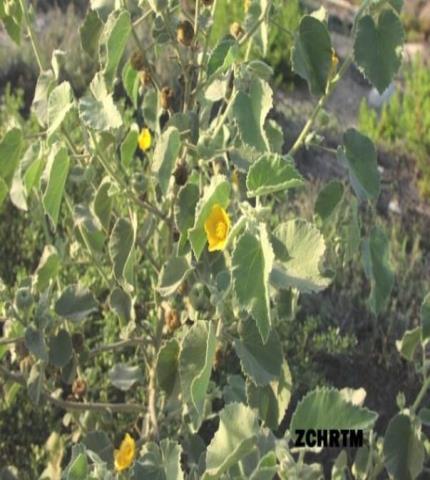
Aerial parts
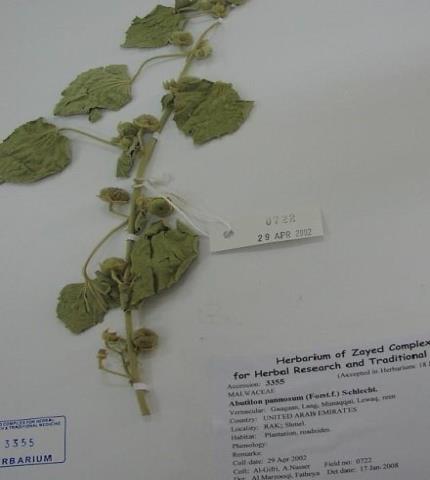
Herbarium specimen
Ethnobotanical Characteristics
Description
Erect, 1.5-3 m tall perennial herb to shrub, stellate pubescent, velvety. Leaves 4-13 cm across, broadly ovate, sub entire to irregularly serrate or serrulate, obtuse to acuminate at apex, cordate at base, 7-9 nerved, velvety and stellate pubescent on both sides, more so beneath; petiole 2-15 cm long; stipules lanceolate, falcate, 4-7 mm long, 2 mm broad, reflexed, caducous. Flowers axillary, basically solitary, appearing in racemes or panicles in terminal branches by the reduction of leaves; pedicel 1-3.5 cm long, uniformly hairy, articulate from below the middle to near the apex. Calyx 8-10 mm long, in fruit up to 12 mm, fused to or below the middle, pubescent on both sides, stellate without and fasciculate within; lobes 4-8 mm long, ovate, lanceolate to broadly ovate or deltoid, acuminate. Corolla 3-4.5 cm across, yellow; petals 1.5-2 cm long, 1.3-1.7 cm broad, obovate, oblique, slightly notched, claw hairy on the margin. Staminal tube ± 5 mm long, stellate pubescent. Fruit globose, 10-15 mm across, villose, ridges and furrows conspicuous, visible, mericarps (20-) 24-28 (-31), 7-9 mm long, 4-5 mm broad, reniform, obtuse, laterally smooth, and glabrous, hairy on the dorsal margin, separating after dehiscent. Seeds 3 in each mericarp, 2-2.5 mm long, 2 mm broad, usually reniform (Jongbloed, 2003; e-Floras).
Habitat and Distribution
The plant is widespread in Tropical Africa, Pakistan and India. In the UAE this plant is widely spread especially in the Northern Emirates, found at roadsides and under plantations.
Part(s) Used
Whole plant and aerial parts.
Traditional and Medicinal Uses
The plant is used by traditional medicine practitioners for the treatment of diarrhea, dysentery and stomach troubles (Al-Yayha, 1990).
Pharmacognosy and Phytochemistry
Plant material Studied
Dried leaf
General appearance
It is yellowish-green in colour, cordate petiolate, with prominent venations and dentate to serrate margins. It curls inwards at the base of the lamina. Its lower surface has velvet-like feeling.
Microscopical characteristics
The leaf is dorsiventral and it is obscured by dense covering trichomes on both surfaces with their multi cellular bases embedded between the epidermal cells. The majority of the trichomes are stellate in structure but single, long, tapering ones or those multi cellular glandular trichomes with rounded blunt tips are also observed. The cuticle is not detected. The upper and lower epidermises consist of small polygonal cells. The upper epidermis is underlain by a layer of palisade tissues consisting of long, narrow, compactly packed parenchyma cells with occasional short, broad ones. The spongy mesophyll tissues consist of many layers of rounded or club-shaped parenchyma cells. Both palisade and spongy mesophyll cells contain cluster crystals of calcium oxalate, and normally one crystal is contained by a palisade cell while the spongy cells contain many small-sized crystals. Vascular tissues are embedded by the spongy mesophyll cells at the central part of the leaf; most vessels are annularly thickened.
Powdered plant material
Parts studied
leaf
The material consists of the pounded leaf. It is a yellowish-green very fine homogeneous powder with an odour of dry straw and a slightly acrid taste. Microscopically, the powder shows numerous covering trichomes of different types including stellate, two and three-branched trichomes in addition to unicellular long tapering ones. They are either detached or on their bases on the leaf fragments. Most of the leaf fragments are obscured by the covering trichomes but unobscured ones show many rosettes of calcium oxalate in the mesophyll region; they also show the multicellular glandular trichomes. Scattered calcium oxalate rosettes are also observed.
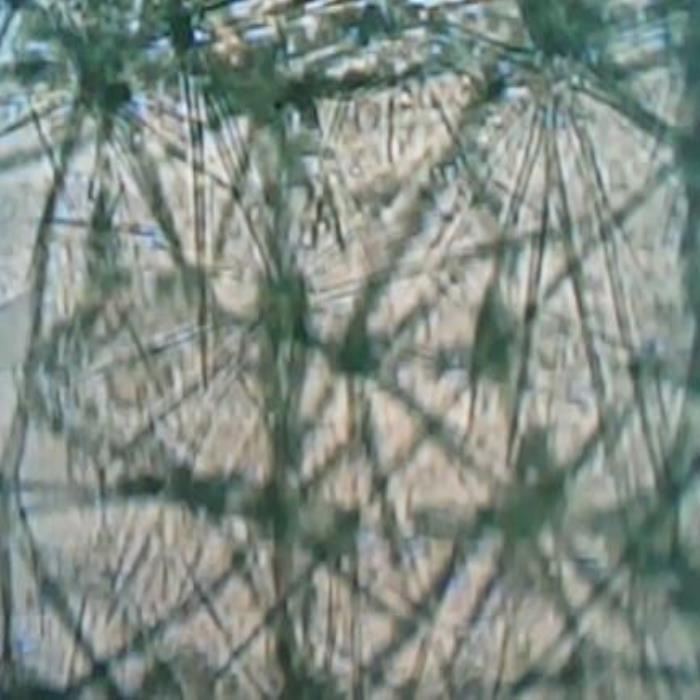
A) Leaf surface view

B) Portion of leaf
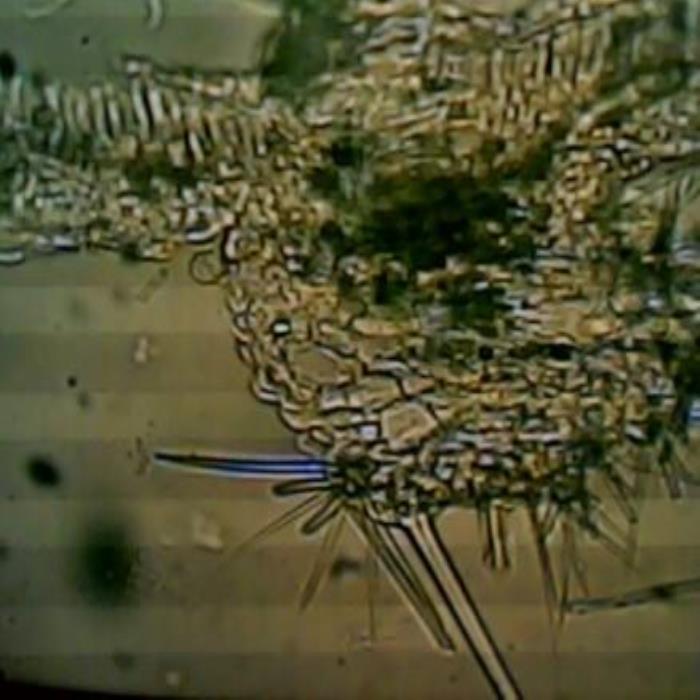
C) T S of leaf
- A. Surface view of the leaf showing numerous stellates covering trichomes obscuring the leaf surface.
- B. Portion of the leaf showing tapering and stellate covering trichomes including a detached covering trichome with a bulbous basal cell. The dark areas are occupied by cells rich in cluster crystals of calcium oxalate.
- C. TS of the leaf at the mid-rib region showing part of the epidermis underlain by a layer of long narrow palisade cells at the left; the lower epidermis with long tapering and stellate covering trichomes on the right. Above the lower epidermis is the spongy mesophyll tissues occupying a large zone consisting of rounded or club-shaped parenchyma cells. The dark area consists of spongy mesophyll cells rich in calcium oxalate crystals.
Chemical constituents
Literature revealed the presence of flavonoids, tannins, sterols, triterpenes and volatile bases in the aerial parts. The seeds contain: palmitic, stearic, oleic, linoleic, malvalic, sterculic and dihydrosterculic acid (Al- Yahya, 1990). The seed oil content: palmitic acid (16.8-21.3%), oleic acid (10.9-11.7 %), linoleic acid (60.7-63.9 %), stearic acid 2.8%, malvalic acid 2.2% and dihydrosterculic acid 1.3% and traces of linolenic and sterculic acids. Alpha and Gamma tocopherol are the major tocopherols in the oil of Abutilon pannosum (Kittur, 1982; Mariod, 2008). Leaves contain glucose, fructose, galactose, alanine, glutamic acid, arginine and valine. Leaves and fruits contain kaempferol and quercetin as major flavonoids (Rastogi, 1995; 1993).
The following chemical studies have been carried out (Quality Control methods, 1998; Evans, 1996) on the aerial part of the plant Abutilon pannosum (ZCHRTM unpublished work):
Physicochemical constants
Loss of weight on drying at 105°C: 8.60
Absolute alcohol solubility: 1.60
Water solubility: 18.00
Successive extractives (%)
Petroleum ether (60-80) °C: 2.00
Chloroform: 1.60
Absolute alcohol: 10.00
pH values (aqueous solution)
pH of 1% solution: 6.018
pH of 10% solution: 5.442
Ash values (%)
Total ash (British Herbal Pharmacopeia): 10.00-10.80
Water soluble ash: 5.17
Acid insoluble ash (10% HCl): 0.120- 0.619
Elemental Analysis
Assay and identification of elements (AOAC International)
|
Apparatus |
AA-6800 Shimadzu-Flame method |
||||
|
Element |
Std. conc. µg/ml(ppm) |
Sample conc. mg/ml |
Sample absorbance |
Actual conc. mg/ml |
Actual conc. |
|
Cr |
1, 2, 4 |
40.044 |
0.0020 |
0.0074050 |
0.0007405 |
|
Zn |
0.5, 1, 2 |
40.044 |
0.4711 |
0.0630375 |
0.0063075 |
|
Cu |
0.5, 1, 2 |
40.044 |
0.0413 |
0.0013910 |
0.00013910 |
|
Fe |
1, 2, 4 |
40.044 |
0.3007 |
0.037918 |
0.0037918 |
|
K |
1, 2, 4 |
40.044 |
2.0806 |
0.6651525 |
0.066515 |
|
Pb |
1, 2, 4 |
40.044 |
0.0011 |
0.00409 |
0.000409 |
|
Cd |
0.25, 0.5, 1 |
40.044 |
0.000 |
0.000 |
0.000 |
1ppm conc. = 1µg/ml; Actual conc. (%) =Actual conc.(ppm) x 0.0001 [1ppm=0.0001%]
UV Spectral studies
|
Sample conc. (mg / ml) |
Solvent |
λ max (nm) |
λ min (nm) |
Abs. (λ max - λ min) |
|
0.886 |
Intestinal Fluid simulated without pancreatic pH=7.5 0.1 |
277 |
259 |
0.410 – 0.365 |
|
1.06 |
Gastric Fluid simulated without pepsin pH =1.2 0.1 |
271 |
238 |
0.729 – 0.215 |
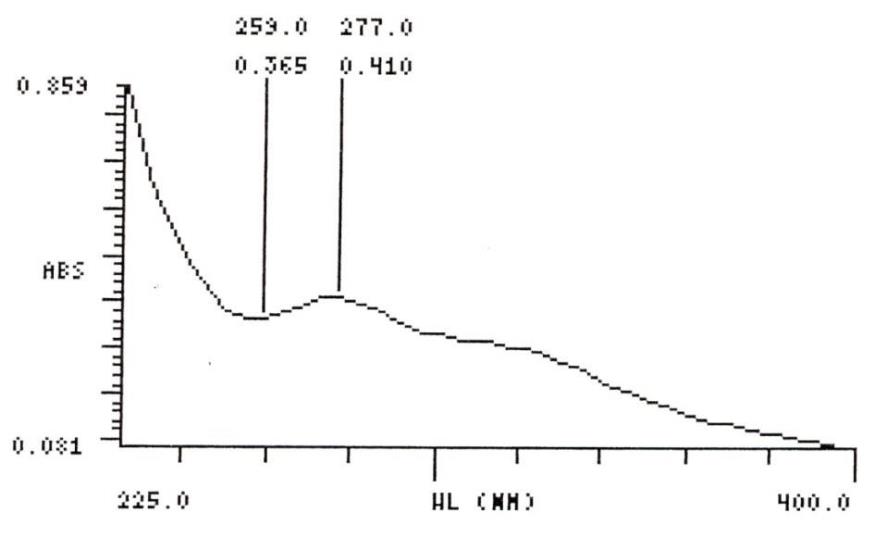
Intestinal Fluid simulated without pancreatic
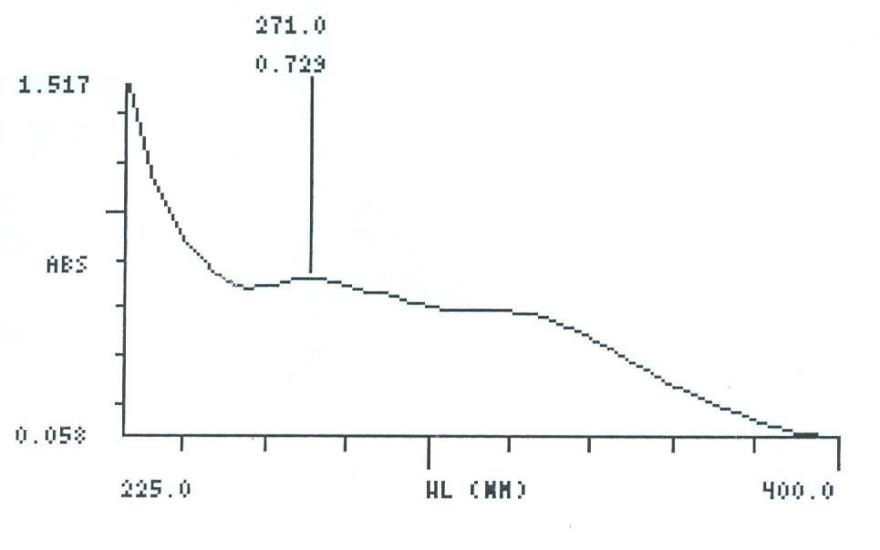
Gastric Fluid simulated without pepsin
Chromatographic Studies
Thin layer chromatography (Wagner and Bladt, 1996)

A
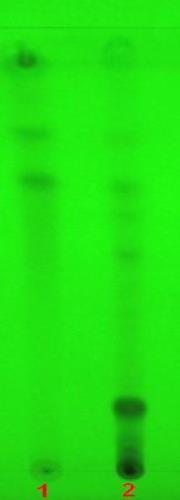
B
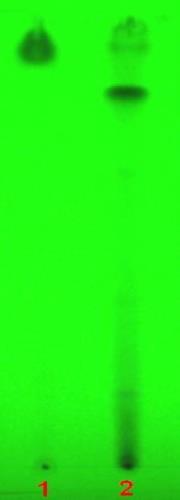
C

D
TLC fingerprint of Petroleum ether (60-80) °C extract (track 1) and Methanol extract (track 2)
|
Mobile phase Fig. |
A&D |
: |
Toluene, ethyl acetate (93:7) |
|
|
B |
: |
Toluene, ethyl formate, formic acid (5:4:1) |
|
|
C |
: |
Ethyl acetate, methanol, water (100:13.5:10) |
|
Detection |
A |
: |
UV 366nm |
|
|
B&C |
: |
UV 254nm |
|
Derivatization |
D |
: |
Vanillin-Sulphuric acid- vis. |
Pharmacological and Toxicological Studies
Aqueous extract
Literature revealed that the ethanol extract exhibited spasmogenic effects on isolated guinea pig ileum and a fall in blood pressure of normotensive anaesthetized rabbit. Both of these effects were antagonized by atropine, suggesting muscaranic type cholinergic activity. However, the chloroforms extract showed atropine like activity in the guinea pig ileum.
The plant has been reported to possess hepatoprotective, anti-plasmodic and hypoglycemic activities (Kang, 2007). The ethanolic extract caused only a significant decrease in the serum sodium contents of rats. No appreciable change in RBC and WBC counts and Hb level were noted in hematological analysis. Prothrombin time was, however, significantly decreased by both ethanolic and chloroform extracts in blood coagulation studies (Al-Yahya, 1990). The toxicological studies showed that the ethanolic extract produced writhing, piloerection, urination, hypothermia and rapid respiration in mice (Mohammad, 1990).
The ethanolic extract exhibited spasmogenic effects on isolated guinea pig ileum and a fall in blood pressure of normotensive anaesthetized rabbit. Both of these effects were antagonized by atropine, suggesting muscarinic type cholinergic activity. However, the chloroforms extract showed atropine like activity in the Guinea pig ileum. Both extracts were found to inhibit the acetyl chorine induced contraction of isolated frog’s rectus abdominis muscles (Al-Yahya, 1990).
The following pharmacological and safety evaluation studies were carried out in ZCHRTM labs. on the aqueous extract of the plant Abutilon pannosum (Derelanko 2002; Han, 2003):
|
ACTIVITY |
RESULTS |
|||
|
Strong |
Moderate |
Mild |
Negative |
|
|
Analgesic |
✅ |
|||
|
Antidepressant |
✅ |
|||
|
Anti-gastric ulcer activity |
✅ |
|||
|
Anticonvulsant |
✅ |
|||
|
Effect on rabbit jejunum |
✅ |
|||
|
Effect on rat fundus |
✅ |
|||
|
Effect on Guinea pig ileum |
✅ |
|||
|
Effect on Guinea pig tracheal chain |
✅ |
|||
|
Effect on right rat atria |
✅ |
|||
|
Antithrombotic effect |
✅ |
|||
|
Uterotropic |
✅ |
|||
|
Studies on biochemical parameters |
✅ |
|||
|
Studies on hematological parameters |
✅ |
|||
|
Effect on onset and duration of pentobarbitone sleeping |
✅ |
|||
|
Motor co-ordination (grip strength & motor activity |
✅ |
|||
|
Rectal temperature |
✅ |
|||
|
Body weight |
✅ |
|||
|
Vital organs |
✅ |
|||
Summary of the results
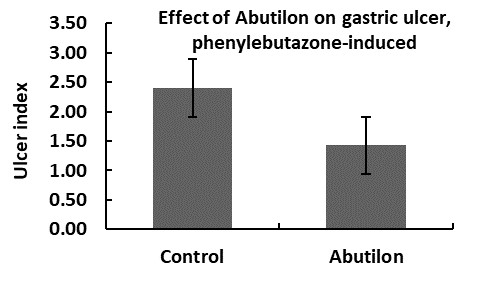
Effect of Abutilon on gastric ulcer phenylbutazone induced
The extract of the plant produced a significant gastro-protective activity; positive Inotropic activity; displayed strong dose-dependent contraction of the gastric fundus smooth muscles (Spasmogenic effects). Studies on biochemical parameters following the plant extract administration at the dose of 1 g/kg b.wt., daily, for 15 days resulted in serum biochemical changes in cholesterol and alanine transaminase decreased and alkaline phosphatase increased significantly. No significant change was found in hematological parameters.
The oral administration of the plant extract was non-toxic up to a dose of 10 g/kg b. wt., p.o. These studies demonstrated that the plant extract is safe and did not cause any detrimental effects in vivo in this study.
The plant extract administered for seven days demonstrated no significant analgesic, antihistaminic, antidepressant, Uterotropic activities nor anticonvulsant effect and pentobarbitone-induced sleep hypnosis.
For repeated dose toxicity the plant extract was tested at the dose rate of 1g/kg/day and distilled water (control) for a period of 14 days. No change in body weight was recorded. There was no significant change in the weight of vital organs were observed. The pathological examination of the internal organs revealed that there were no signs of abnormalities.
Antimicrobial activity
The aqueous extract of the whole plant did not inhibit the growth of any of the following microorganisms studied: Mycobacterium smegmatis, Candida tropicalis, different strains of Methicillin Resistant Staphylococcus aureus, different strains of ESBL-producing K. pneumonia, E. coli, Pseudomonas aeruginosa.
References
- Al-Yayha, M. A., Al-Mesha, I. A., Mossa, J. S., Al-Badr, A. A. & Tariq, M. (1990) Saudi Plants A Phytochemical and Biological Approach. Gerneral Directorate of Research Grants Programs- King Abdul Aziz City for Scicence & Technology, Riydh, Saudia Arabia.
- Jonbloed, M. V., Feulner, G. R., Boer, B. & Western, A. R. (2003). The Comprehensive Guide to the Wild Flowers of the United Arab Emirates, Erwda, Abu Dhabi, U.A.E.
- Kang-Jin Cho, Hiba A Ali, Jung-Bong Kim, May H, Elamin L, Chanyoung Ki, Sam Sun Kim. Flavonoid profiling, radical scavenging activity and antimicrobial activity of two Abutilon Spp. Abstract No. LB76 Late-breaking Abstracts, Experimental Biology 2007. Washington Convention Center–Exhibit Hall C, Concourse Level.
- M. H. Kittur, C. S. Mahajanshetti, K. V. S. A. Rao and G. Lakshminarayana. Characteristics and composition of Abutilon pannosum and Hibiscus panduriformis seeds and oils. Journal of the American Oil Chemists' Society .Vol. 59, No. 3(March1982) /123-124.
- Mariod Abdalbasit; Matthaus Bertrand. Physico-chemical properties, fatty acid and tocopherol composition of oils from some Sudanese oil bearing sources. Grasas y aceites, 2008, vol. 59, No.4, p. 321-326.
- Rastogi & Mehrotra, Compendium of Indian medicinal plants: vol. 3, PID, New Delhi,1993, p.4.
- Rastogi & Mehrotra, Compendium of Indian medicinal plants: vol. 4, PID, New Delhi, 1995, p.2.
- ZCHRTM, DPH&P, HAAD (Unpublished results).
